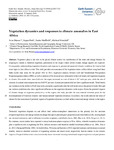Vegetation dynamics and responses to climate anomalies in East Africa

View/
Date
2018Author
Musau, John Mwanzia
Patil, Sopan
Sheffield, Justin
Marshall, Michael
Metadata
Show full item recordAbstract
Vegetation plays a key role in the global climate system via modification of the water and energy balance. Its
coupling to climate is therefore important, particularly in the tropics where severe climate change impacts are expected.
Consequently, understanding vegetation dynamics and response to present and projected climatic conditions for various land
cover types in East Africa is vital. This study provides an assessment of the vegetation trends in East Africa using Leaf Area
Index (LAI) time series for the period 1982 to 2011, regression analysis between LAI and Standardised Precipitation
Evapotranspiration Index (SPEI), as well as analysis of the temporal non-stationarity in the LAI trends and vegetation response
to climate. Our results show mean LAI over the region increased at a rate of about 4×10-3 units per year, while the rate of
increase for annual mean temperature was 0.035°C per year. Annual precipitation did not show significant trends. Trend breaks
and variations in the stability of LAI time series anomalies significantly alter the LAI trends across the period of study. Drought
and wetness conditions also show significant influence on the vegetation dynamics in the region. Given the potential impacts
of climate change on vegetation productivity in this region, this study provides the much-needed reference point for the
disentanglement of historical climatic- and human-induced vegetation dynamics. In addition, the results indicate key areas of
interest for the assessment of potential impacts of vegetation dynamics on land surface water and energy balance in the region.
